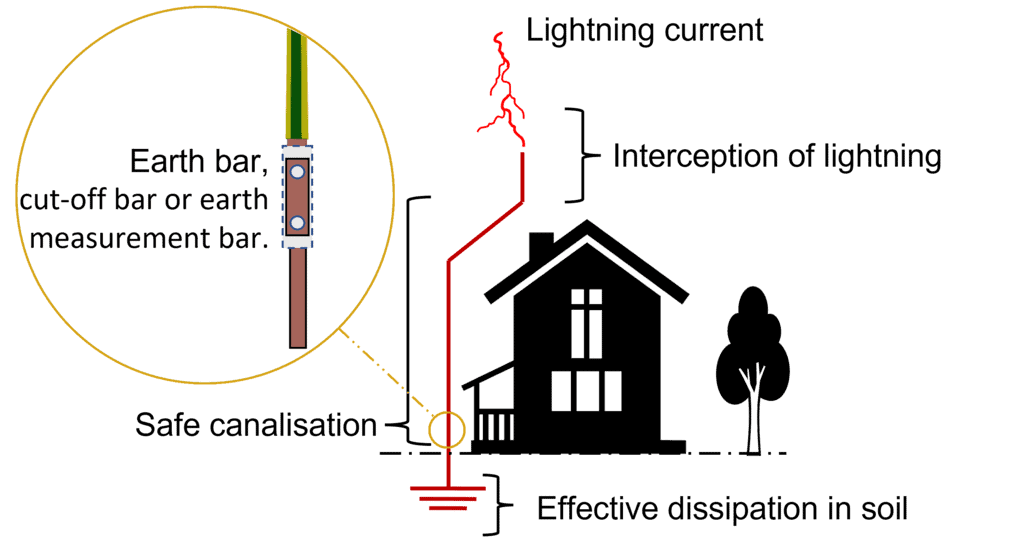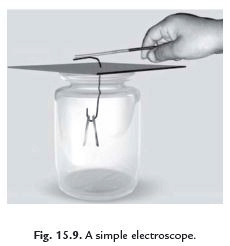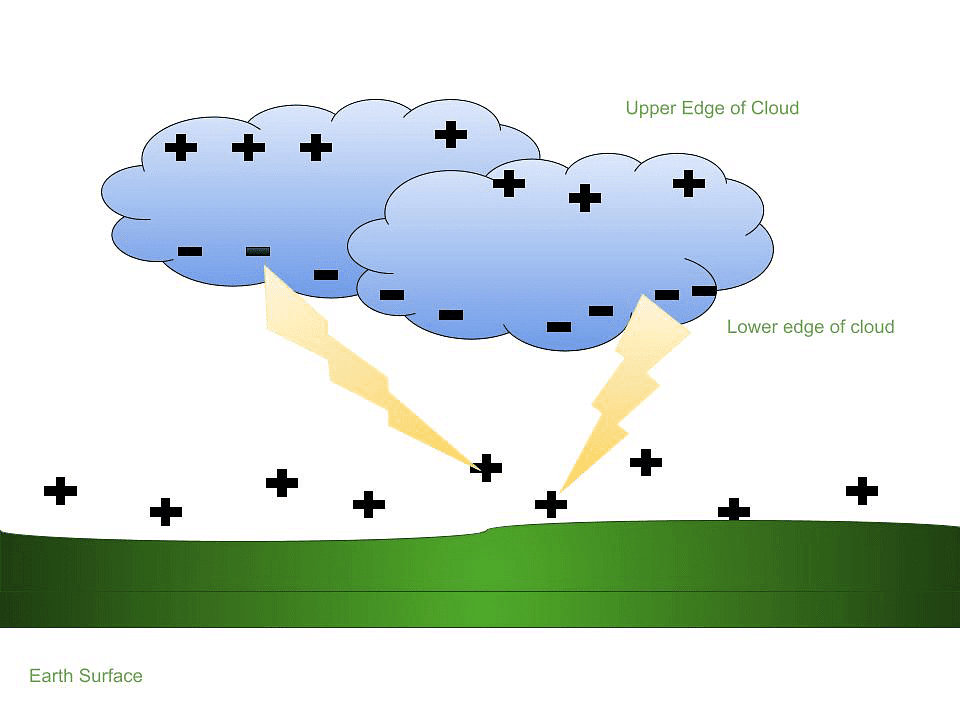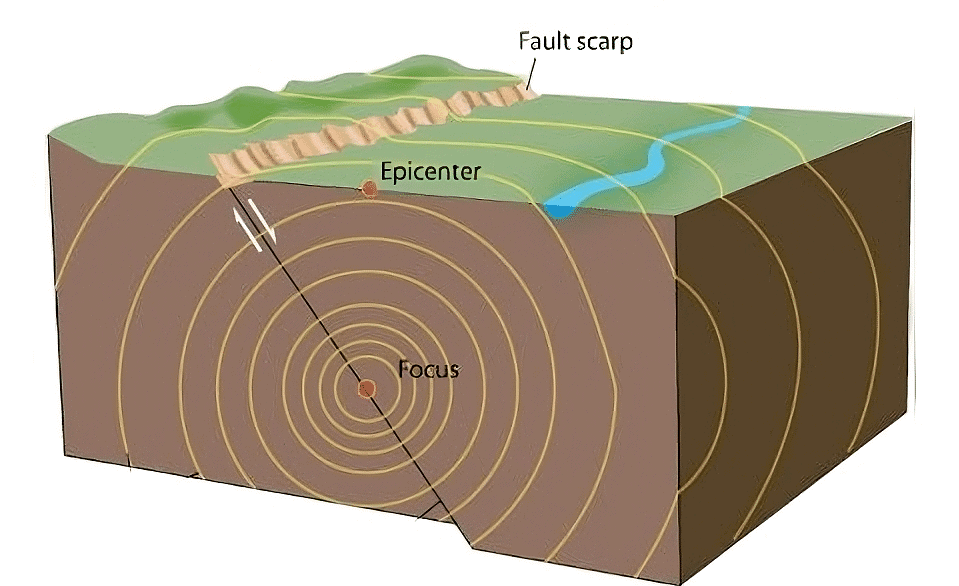Class 8 Science Chapter 12 Question Answers - Some Natural Phenomena
In this Chapter of the Class 8 Science curriculum, we delve into the fascinating world of natural phenomena, specifically lightning, and earthquakes. The chapter delves into crucial measures that can be implemented to mitigate the devastating effects caused by these occurrences. Let's explore some long answer questions from this chapter.

Q1: Explain an Electroscope and Earthing.
Ans:
- An Electroscope is a device used to detect the type of charge present on an object. It consists of a glass jar with a cork lid through which a metallic wire passes. At the bottom of the wire, there are two metallic strips, while the upper end of the wire is connected to a metal disc. When a positively charged object is touched to the metal disc, the charge is transferred to the metal strips through the wire, causing them to repel each other due to their like charges. Similarly, if a negatively charged object is brought into contact with the disc, the strips will converge towards each other, indicating the presence of an unlike charge. This allows us to determine the nature of the charge on a body.
 Electroscope
Electroscope
- Earthing, on the other hand, is the process of transferring the charge from a charged object to the Earth. It is an important safety measure in which most electrical appliances and the mains of a house are connected to the Earth. This connection prevents us from getting an electric shock by providing a safe path for the excess charge to dissipate.

Q2: Explain two natural destructive phenomena.
Ans:
- Lightning: Lightning occurs during the formation of a thunderstorm when air currents move upward and water droplets move downward. This creates a separation of charges, with positive charges gathering near the upper edges of the clouds and negative charges accumulating near the lower edges. Sometimes, positive charges also accumulate near the ground. When the accumulated charges reach a high magnitude, the air, which is typically a poor conductor of electricity, can no longer resist their flow. This results in the meeting of positive and negative charges, leading to streaks of bright light and sound known as lightning. The process is called an electric discharge and can occur between clouds or between clouds and the Earth. Lightning strikes can cause significant damage to life and property, making it essential to implement measures for protection.
 Lightning
Lightning - Earthquake: An earthquake is a sudden shaking or trembling of the Earth's crust, resulting from a disturbance deep within the Earth. While earthquakes occur frequently all over the Earth, major destructive earthquakes are less common but can cause immense damage to buildings, bridges, dams, and pose risks to human life. Earthquakes can be triggered by various factors such as volcanic eruptions, meteor impacts, or underground nuclear explosions. However, the majority of earthquakes are caused by the movement of the Earth's tectonic plates. The boundaries where these plates interact are known as seismic or fault zones, which are particularly vulnerable to earthquakes. The severity of an earthquake is measured on the Richter scale, with highly destructive earthquakes having magnitudes above 7 on this scale.

Q3: Explain the construction and working of electroscope.
Ans: It is an instrument used to detect electric charges.A simple electroscope can be constructed as follows.
(i) Take a glass container.
(ii) Insert a metal wire inside it.
(iii) To the ends of the wire, which are inside the jar, attach 2 metal plates(say aluminium plates).
(iv) The other end is outside the glass container is connected or brought in contact with charged body.
 Working of an Electroscope:
Working of an Electroscope:
(i) In an uncharged electroscope, the leaves hang straight down.
(ii) When a charged object touches the metal knob, electric charges travel down the rod and into the leaves.
(iii) The leaves spread apart, indicating the presence of an electric charge.
(iv) Since the charge on both leaves is the same the leaves repel each other and spread out.
Q4: Explain the mechanism of thunderstorms.
Ans: During the development of a thunderstorm, the air currents move upward while the water drops move downward. These movements cause separation of charges. The positive charges collect near the upper edges of the clouds and negative charges accumulate near the lower edges. There is accumulation of positive charges near the ground also. When the amount of accumulated charges becomes very large, the air which is normally a poor conductor of electricity, is no longer able to resist their flow. Negative and positive charges meet, producing streaks of bright light and sound. This process is called an electric discharge. The process of electric discharge can occur between two or more clouds or between clouds and the earth. In this way thunderstorm is caused.
 Accumulation of Charges Leading to Lightining
Accumulation of Charges Leading to Lightining
Q5: How can you save yourself from lightning?
Ans: Some safety measures are:
(i) We should run to take shelter in the house.
(ii) We should remain in the covered area.
(iii) We should not sit in open, on scooters or bike etc.
(iv) We should take shelter under a small tree while in open.
(v) If there is no tree or other shelter we should sit with head folded.
(vi) We should plug out all the electrical appliances during lightning.
(vii) We should not use wired telephones during lightning. Mobiles and cordless phones are safe.
 Protection during Lightning
Protection during Lightning
Q6: Explain the safety measures during thunderstorm when you are inside your home.
Ans: Some safety measures are as follows:
(i) During a thunderstorm contact with telephone cords, electrical wires and metal pipes should be avoided.
(ii) It is safer to use cordless phones and mobiles.
(iii) Bathing should be avoided during thunderstorm.
(iv) Computer, TV etc. should be unplugged.
Q7: Explain the mechanism of earthquakes.
Ans. The tremors are caused by the disturbance deep down in the uppermost layers of earth. The uppermost layer of earth is called crust. The crust of earth is not a one piece. It is fragmented. Each fragment is called a plate. These plates are in continual motion. When they brush past one another or a plate goes under another due to collision, they cause disturbances and show up as an earthquake on the surface of the earth. Although we know the causes of the earthquake, it is not possible to predict when and where the next earthquake might occur.
 Seismic waves radiate from the focus of an earthquake
Seismic waves radiate from the focus of an earthquake
Q8: What is a seismograph? How does it work?
Ans: The instrument used to record the seismic waves is called seismograph. The tremors produce waves on the surface. The instrument is simply a vibrating rod or a pendulum. Which starts vibrating when tremors occur. A pen is attached to vibrating system. The pen records the seismic waves on a paper that moves under it. By studying these waves scientists construct a map of earthquake. They can also estimate its power to cause destruction.
Q9: What suggestions will you give the people to make ‘Quake Safe’?
Ans: Some suggestions are:
(i) Consult qualified architects and structure engineers.
(ii) Make the structure symmetrical so that the mass is distributed uniformly.
(iii) Use of mud or timber is better than heavy construction.
(iv) The cupboards and shelves are to the walls.
(v) Be careful about where to hang wall clocks, photo frames, water heater,s etc. So that in the event of an earthquake, they do not fall on people.
(vi) All buildings should have fire fighting equipment installed.
Frequently Asked Questions
1. What are natural phenomena?
Ans: Natural phenomena are events that occur in the physical world that are not caused by human beings. These events are often caused by natural forces or processes and can include things like earthquakes, thunderstorms, and volcanic eruptions.
2. How are natural phenomena formed?
Ans: Natural phenomena are formed through a variety of processes and forces. These can include geological processes like plate tectonics and erosion, as well as atmospheric processes like weather patterns and the movement of air masses. Natural phenomena can also be influenced by the interactions between living organisms and their environment.
3. What are some examples of natural phenomena?
Ans: Some examples of natural phenomena include lightning strikes, tornadoes, hurricanes, earthquakes, volcanic eruptions, and tsunamis. Other examples can include phenomena related to the movement of celestial bodies, such as eclipses and meteor showers. $$$
4. How can natural phenomena be dangerous?
Ans: Natural phenomena can be dangerous due to their unpredictable nature and their potential to cause harm to human beings and their environment. For example, hurricanes and tornadoes can cause widespread destruction to homes and infrastructure, while earthquakes and volcanic eruptions can lead to loss of life and displacement of communities. Lightning strikes can also be dangerous, causing injuries and fires.
5. Can humans predict natural phenomena?
Ans: While scientists have made significant progress in understanding natural phenomena, predicting them with complete accuracy is still a challenge. However, there are many tools and techniques that can be used to monitor and forecast natural phenomena, such as seismometers for earthquakes and Doppler radar for thunderstorms. This information can be used to issue warnings and help mitigate the potential impact of these events.
|
90 videos|296 docs|44 tests
|

















